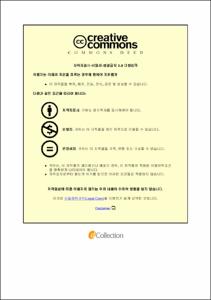거북모사 유체동력 터빈 설계를 위한 매개변수 연구
- Alternative Title
- A Parametric Study for the Design of a Turtle-Mimicking Hydrokinetic Turbine
- Abstract
- Flapping-foil hydrokinetic turbine (FHT) are inspired by nature and have recently been presented in various forms. In this study, a parametric analysis was performed to design a tandem hydrokinetic turbine with four hydrofoils mimicking a quadruped aquatic animal and its movements. A Navier-Stokes-based computational fluid dynamics (CFD) code was used as the analysis tool, and the performance in terms of power and load was compared and analyzed by varying the pitch angle, reduced frequency (f*), separation distance, and phase difference of each hydrofoil.
In the first parametric analysis, the pitch angle and dimensionless frequency were set to the smallest values in the given parameter range, focusing on power efficiency and fluctuation. Then, based on the proposed performance metrics and the room for improvement, additional parametric analyses were performed by selecting the 90° front-lead condition for the longest distance of 6c and the 90° rear-lead condition for the shortest distance of 2c. The subsequent parametric analysis showed that the 90° front-lead with a pitch angle of 70°, a reduced frequency of 0.12, and a distance of 4c was the final optimal condition in terms of system length and power balance, with an efficiency of 59.48% and fluctuation of 55.44%.
Next, the performance of each hydrofoil was compared and analyzed in terms of power and load under in-phase and out-of-phase conditions. After optimizing the reduced frequency and separation distance, the out-of-phase condition showed superior characteristics in terms of power, with similar efficiency and lower fluctuations compared to the in-phase condition. As for the loads on the system body, the load level remains lower in the out-of-phase condition compared to the in-phase condition, which is favorable for the design of the structure supporting the turbine. Therefore, the FHT proposed in this study can utilize three or more hydrofoils similar to a conventional rotary turbine, and the performance of the FHT can be improved by phase control between the hydrofoils.|플래핑-포일 유체동력 터빈(flapping-foil hydrokinetic turbine, FHT)은 회전식 터빈과 달리 자연에서 영감을 얻었으며 최근 다양한 형태로 연구되었다. 본 연구에서는 네발 달린 수생 생물과 그 움직임을 모방한 4개의 수중익을 갖춘 직렬 유체동력 터빈(tandem flapping-foil hydrokinetic turbine, TFHT)을 설계하기 위해 매개변수 분석(parametric analysis)을 수행했다. 분석 도구로는 나비에-스토크스(Navier-Stokes) 기반의 전산유체역학(computational fluid dynamics, CFD) 코드를 활용하여, 각 수중익의 피치각(pitch angle), 무차원주파수(reduced frequency, f*), 이격거리(separation distance), 위상차(phase difference)를 변화시키는 등 조건을 바꿔가며 출력 및 부하 측면에서 성능을 비교하고 분석했다.
1차 매개변수 분석에서는 먼저 피치각과 무차원주파수를 주어진 매개변수 범위 중 가장 작은 값으로 고정하여 출력 효율(power efficiency)과 변동성(power fluctuation)을 중점으로 분석하였다. 분석 결과를 기반으로 가장 거리가 긴 6c일때 앞쪽 리드(front-lead) 조건과 가장 짧은 거리인 2c일때 뒤쪽 리드(rear-lead) 조건을 선택하여 매개변수 분석을 진행했다. 이후 추가적인 매개변수 분석을 통해 앞쪽 리드, 70도의 피치각, 0.12의 무차원주파수, 4c의 이격거리 조건에서 59.48% 효율과 55.44% 변동을 가지며 시스템 길이와 출력 성능면에서도 분석 사례 중 최적조건이라는 것을 도출했다.
다음으로는 각 수중익을 동위상(in-phase) 및 역위상(out-of-phase)조건으로 나누어 출력 및 부하 측면에서 성능을 비교하고 분석했다. 분석 결과, 역위상 조건은 동위상 조건과 비교했을 때, 효율은 비슷하고 변동이 더 낮아 출력 성능 측면에서 우수한 특성을 나타냈다. 시스템의 몸체에 가해지는 하중의 경우, 동위상 조건에 비해 역위상에서의 하중 수준이 낮게 유지되어 터빈을 지지하는 구조 설계에 유리하다. 따라서 본 연구에서 제안하는 FHT는 일반적인 회전식 터빈과 유사하게 3개 이상의 수중익을 활용할 수 있으며, 수중익 간의 위상 조절을 통해 FHT 성능을 향상시킬 수 있다.
- Issued Date
- 2024
- Awarded Date
- 2024-02
- Type
- Dissertation
- Alternative Author(s)
- Jeong Da som
- Affiliation
- 제주대학교 대학원
- Department
- 대학원 에너지응용시스템학부
- Advisor
- 고진환
- Table Of Contents
- I. 서론 1
1. 유체동력 터빈(Hydrokinetic turbine) 1
2. 생체모방 기술을 적용한 플래핑-포일 시스템(flapping-foil system) 2
1) 생체모방 추진기(biomimetic thruster) 2
2) 생체모방 발전기(biomimetic generator) 3
3. 플래핑-포일 유체동력 터빈(flapping-foil hydrokinetic turbine, FHT)의 운동학 4
4. 직렬 플래핑-포일 유체동력 터빈(tandem flapping-foil hydrokinetic turbine, TFHT) 7
5. 거북이의 움직임 모사 연구 9
6. 연구 목표 12
II. 반쪽 직렬 플래핑-포일 유체동력 터빈(TFHT) 설계 13
1. 설계 컨셉 및 사양 13
2. 수치 해석 도구 17
1) CFD 코드 및 그리드 시스템(grid system) 정보 17
2) 수렴성 확인 및 수렴해 검증 19
3) 성능 지표 22
3. TFHT 매개변수 분석 계획 26
1) 이격거리(Lx) 및 위상차(1-2) 26
2) 피치각(pitch angle, θ)및 무차원주파수(reduced frequency, f*) 27
4. 결과 및 논의 28
1) 기본 조건 세트에서 이격거리와 위상차의 영향 29
2) 피치각(pitch angle) 영향 33
3) 무차원주파수(reduced frequency, f*) 영향 35
4) 대표 사례의 결과 비교 36
5) 추가적인 해석 조건 및 최종 최적 결과 42
5. 소결론 46
III. 양쪽 4개 수중익을 가진 TFHT설계 47
1. 생체 모방 방식 및 시스템 47
1) 동위상 및 역위상 47
2) 시스템 사양 및 매개변수 49
2. 수치적 해석 방법 50
1) 수렴성 확인 50
2) 성능 지표 52
3. 해석 계획 53
1) 앞뒤 수중익의 출력 성능 분석 계획 53
2) 하중해석을 위한 4개의 수중익 위상 55
4. 결과 및 논의 56
1) 앞뒤 수중익의 출력 성능 56
2) 터빈 본체 하중해석 69
5. 소결론 71
IV. 결론 72
Reference 74
Abstract 78
- Degree
- Doctor
- Publisher
- 제주대학교 대학원
- Citation
- 정다솜. (2024). 거북모사 유체동력 터빈 설계를 위한 매개변수 연구.
- Appears in Collections:
- Faculty of Applied Energy System > Mechanical Enginering
- 파일 목록
-
-
Download
 거북모사 유체동력 터빈 설계를 위한 매개변수 연구.pdf
기타 데이터 / 5.01 MB / Adobe PDF
거북모사 유체동력 터빈 설계를 위한 매개변수 연구.pdf
기타 데이터 / 5.01 MB / Adobe PDF
-
Items in Repository are protected by copyright, with all rights reserved, unless otherwise indicated.